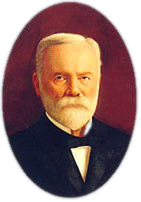|
|
Samuel Willis Tucker Lanham (1846-1908), United States representative and twenty-second governor of the state of Texas, was born on July 4, 1846, to James Madison and Louisa de Aubrey (Tucker) Lanham in Spartanburg District (now County), South Carolina, and named for his maternal grandfather, Samuel Willis Tucker. He was the oldest of eight children; he had four sisters and three brothers. He received a common-school education at Glenn Springs, South Carolina. In 1861 he joined the Confederate Army as a private in the service of Company K, Third South Carolina Regiment, Joseph B. Kershaw's brigade. The unit served primarily with the Army of Northern Virginia but also saw action in Tennessee, North Carolina, and South Carolina. Lanham was wounded at the battle of Spotsylvania in May 1864. He was promoted to second sergeant near the end of the war and surrendered with his command at Greensboro, North Carolina. On September 4, 1866, Lanham married Sara Beona Meng of Union County, South Carolina. The couple left for Texas the next month with nineteen other people and arrived in Red River County in December. Lanham took a job teaching in a country school near Clarksville and later taught at Old Boston after moving to Bowie County. In 1868 he moved his family to Weatherford, where he taught school in one room of a log cabin and lived in the other room. At the same time he studied law and was admitted to the bar in Weatherford in 1869. He was appointed district attorney for the Thirteenth District of Texas by Governor Edmund J. Davis in 1871 and served through 1876. In July 1871 he prosecuted Kiowa Indian chiefs Satanta and Big Tree for their part in the Warren Wagontrain Raid. Lanham, a Democrat, began his political career in 1880, when he was chosen as an elector for the Hancock-English presidential ticket. In November 1882 he was elected to the United States House of Representatives from the Eleventh District of Texas, known as the "jumbo" district because it consisted of ninety-eight counties. He served five terms, until March 1893. He made an unsuccessful run for the Democratic gubernatorial nomination in 1894, losing to Charles A. Culberson. He was again elected to Congress in 1896 and represented the Eighth District until January 1903. In Congress he represented the interests of cattlemen, pursued citizens' claims for Indian depredations, and worked on state and international boundary questions. He also helped to secure a federal court at El Paso. His House committee service included Judiciary, Territories, Military Affairs, Claims, and Irrigation of Arid Lands; he served as chairman of the last two. Lanham secured the 1902 Democratic nomination for governor with no opposition. His campaign was supported by Edward M. House, who dominated Texas politics for over a decade before becoming the confidential advisor of president Woodrow Wilson. Lanham defeated Republican George W. Burkett in the November general election. In 1904 he was reelected, defeating J. G. Lowden. Lanham was the last Confederate veteran to serve as governor of Texas. During his tenure, the Terrell Election Law, which provided for party primary elections, was enacted. As a result, he was the last Democratic gubernatorial candidate to be chosen by the party-convention method. After serving out his second term as governor, he retired to Weatherford in failing health in 1907. He was considered an eloquent speaker and writer, and often made speeches at Confederate veterans' camps throughout Texas. In 1868 he joined the Masons. He received an honorary doctorate from Baylor University in June 1905. Governor Thomas M. Campbell appointed him a regent of the University of Texas in 1907. Illness, including diabetes, prevented him from participating in board meetings after January 1908. Sarah Lanham died in Weatherford on July 2, 1908. On July 29, 1908, Lanham also died in Weatherford, where he was buried. Five of the Lanhams' eight children lived to adulthood. Their son Frederick Garland Lanham served in the United States House of Representatives from 1919 to 1947. Texas novelist Edwin M. Lanham, Jr., was their grandson. BIBLIOGRAPHY: History of Texas, Together with a Biographical History of Tarrant and Parker Counties (Chicago: Lewis, 1895). Frank W. Johnson, A History of Texas and Texans (5 vols., ed. E. C. Barker and E. W. Winkler [Chicago and New York: American Historical Society, 1914; rpt. 1916]). Sidney S. Johnson, Texans Who Wore the Gray (Tyler, Texas, 1907). Virgil Madison Rogers, Family History: Rogers-McCravy-Lanham (Strasburg, Virginia, 1975). Lawrence A. Landis Reprinted with permission from the Handbook of Texas Online, a joint project of the Texas State Historical Association and the General Libraries at the University of Texas at Austin. © 2003, The Texas State Historical Association.
|
